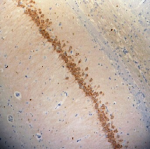- Clone
- NG2 (See other available formats)
- Regulatory Status
- RUO
- Other Names
- Ng, RC3, Calmodulin-Binding Protein, Protein Kinase C Substrate, Hng
- Isotype
- Mouse IgG1, κ
- Ave. Rating
- Submit a Review
- Product Citations
- publications

-

IHC staining of purified anti-Neurogranin (NRGN) antibody (clone NG2) on formalin-fixed paraffin-embedded rat brain tissue. Following antigen retrieval using Sodium Citrate H.I.E.R., the tissue was incubated with 1 µg/ml of the primary antibody for 20 minutes at room temperature. BioLegend´s Ultra-Streptavidin (USA) HRP kit (Multi-Species, DAB, Cat. No. 929901) was used for detection followed by hematoxylin counterstaining, according to the protocol provided. The image was captured with a 40X objective. -

Western blot of purified anti-Neurogranin (NRGN) antibody (clone NG2). Lane 1: Molecular weight marker; Lane 2: 20 µg of human brain lysate; Lane 3: 20 µg of mouse brain lysate; Lane 4: 20 µg of rat brain lysate. The blot was incubated with 1 µg/mL of the primary antibody overnight at 4°C, followed by incubation with HRP labeled goat anti-mouse IgG (Cat. No. 405306). Enhanced chemiluminescence was used as the detection system.
| Cat # | Size | Price | Quantity Check Availability | Save | ||
|---|---|---|---|---|---|---|
| 845602 | 100 µg | £182 | ||||
Neurogranin (NRGN) is the main postsynaptic protein kinase substrate that binds calmodulin in the absence of calcium. It is suggested that the NRGN is a direct target for thyroid hormone in the human brain, and that the control of expression of this gene could underlay many of the consequences of hypothyroidism on mental states during development as well as in adult subjects. Neurogranin in CSF has been implicated as a possible marker for synaptic degeneration in Alzheimer’s disease.
Product DetailsProduct Details
- Verified Reactivity
- Human, Mouse, Rat
- Antibody Type
- Monoclonal
- Host Species
- Mouse
- Immunogen
- KLH conjugated peptide corresponding to residues 52-78 of human neurogranin (NRGN).
- Formulation
- Phosphate-buffered solution, pH 7.2, containing 0.09% sodium azide.
- Preparation
- The antibody was purified by affinity chromatography.
- Concentration
- 0.5 mg/ml
- Storage & Handling
- The antibody solution should be stored undiluted between 2°C and 8°C.
- Application
-
IHC-P - Quality tested
WB - Verified - Recommended Usage
-
Each lot of this antibody is quality control tested by formalin-fixed paraffin-embedded immunohistochemical staining. For immunohistochemistry, a concentration range of 0.5 - 5.0 µg/ml is suggested. For Western blotting, the suggested use of this reagent is 1.0 - 10.0 µg per ml. It is recommended that the reagent be titrated for optimal performance for each application.
- Application Notes
-
The epitope has been mapped to a.a. 52-63 of human NRGN.
- Product Citations
-
- RRID
-
AB_2566622 (BioLegend Cat. No. 845602)
Antigen Details
- Structure
- 78 amino acids with a molecular weight of 7.6 kD.
- Distribution
-
In the cerebral cortex, NRGN is found in the cell bodies of neurons in layers II-VI, and in apical and basal dendrites of pyramidal neurons. It is not found in the dendrites in patients with Alzheimer's disease.
- Function
- Neurogranin is a neuron-specific protein kinase C substrate (post synaptic protein) whose main function is to bind CaM (calmodulin) in the absence of Ca2+. Neurogranin modulates the homeostasis of Ca2+ in neurons and its role has been implicated in learning and memory.
- Ligand/Receptor
- Calmodulin-binding.
- Cell Type
- Neurons
- Biology Area
- Cell Biology, Neuroscience, Signal Transduction, Synaptic Biology
- Molecular Family
- Postsynaptic proteins
- Antigen References
-
1. Zhong L, et al. 2015. J. Neurosci. 35:7503.
2. Huang K, et al. 2004. J. Neurosci. 24:10660.
3. Dominguez-Gonzalez I, et al. 2007. Biochem. J. 404:31.
4. Prichard L, et al. 1999. J. Biol. Chem. 274:7689. - Gene ID
- 4900 View all products for this Gene ID
- UniProt
- View information about Neurogranin on UniProt.org
Related Pages & Pathways
Pages
Related FAQs
Other Formats
View All Neurogranin (NRGN) Reagents Request Custom Conjugation| Description | Clone | Applications |
|---|---|---|
| Purified anti-Neurogranin (NRGN) | NG2 | IHC-P,WB |
Compare Data Across All Formats
This data display is provided for general comparisons between formats.
Your actual data may vary due to variations in samples, target cells, instruments and their settings, staining conditions, and other factors.
If you need assistance with selecting the best format contact our expert technical support team.
-
Purified anti-Neurogranin (NRGN)

IHC staining of purified anti-Neurogranin (NRGN) antibody (c... 
Western blot of purified anti-Neurogranin (NRGN) antibody (c...
 Login / Register
Login / Register 







Follow Us